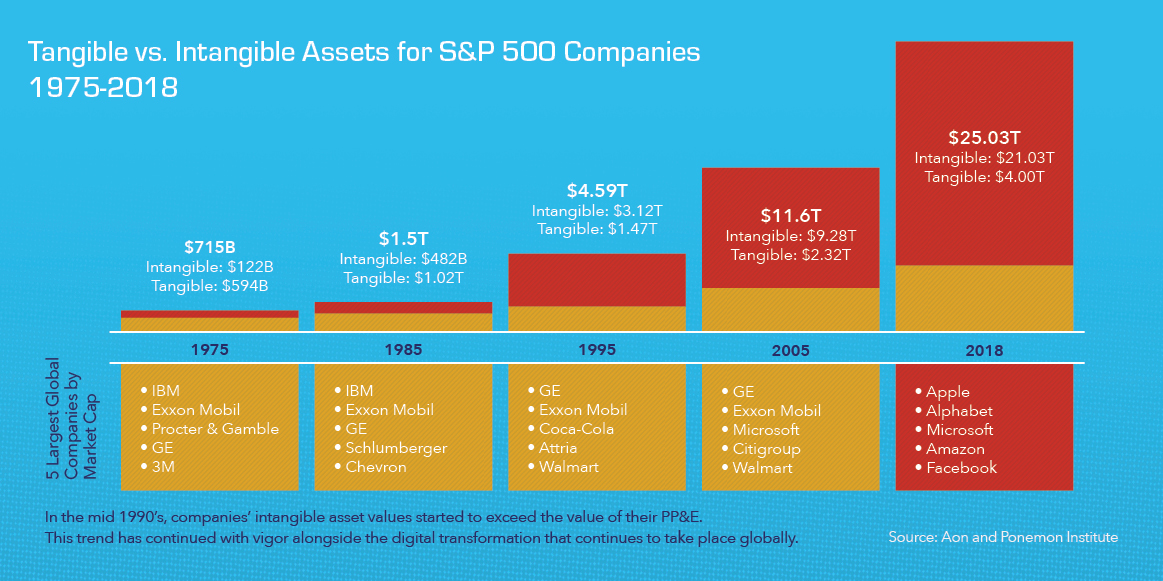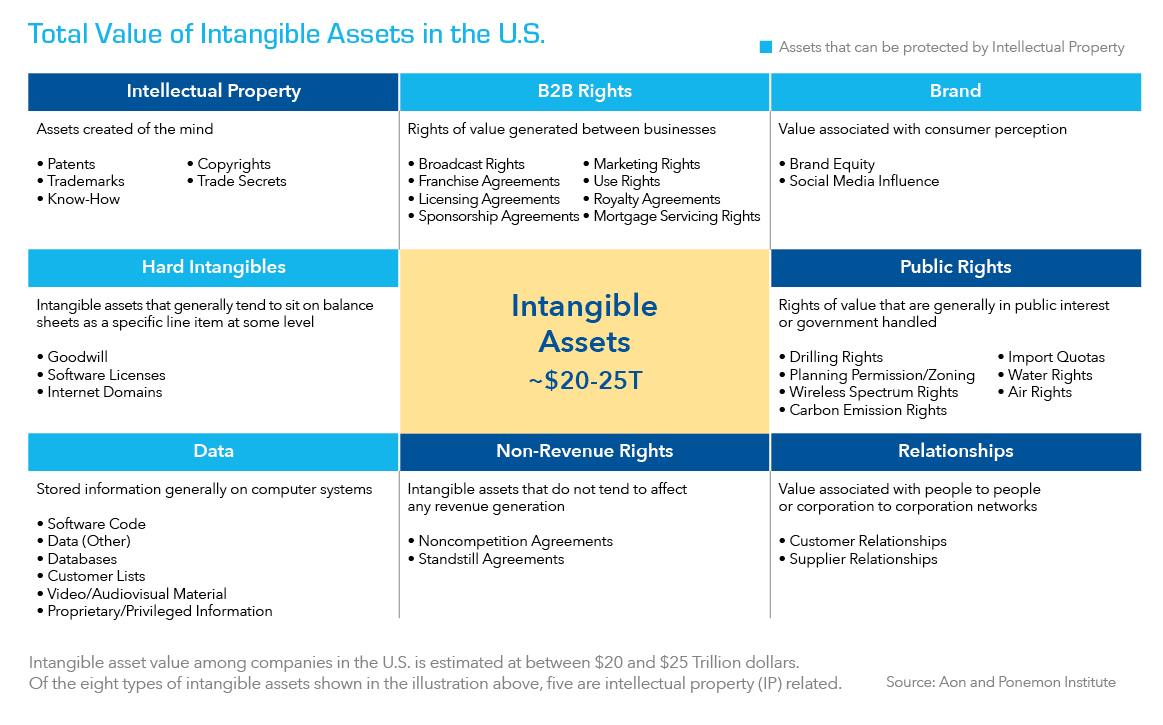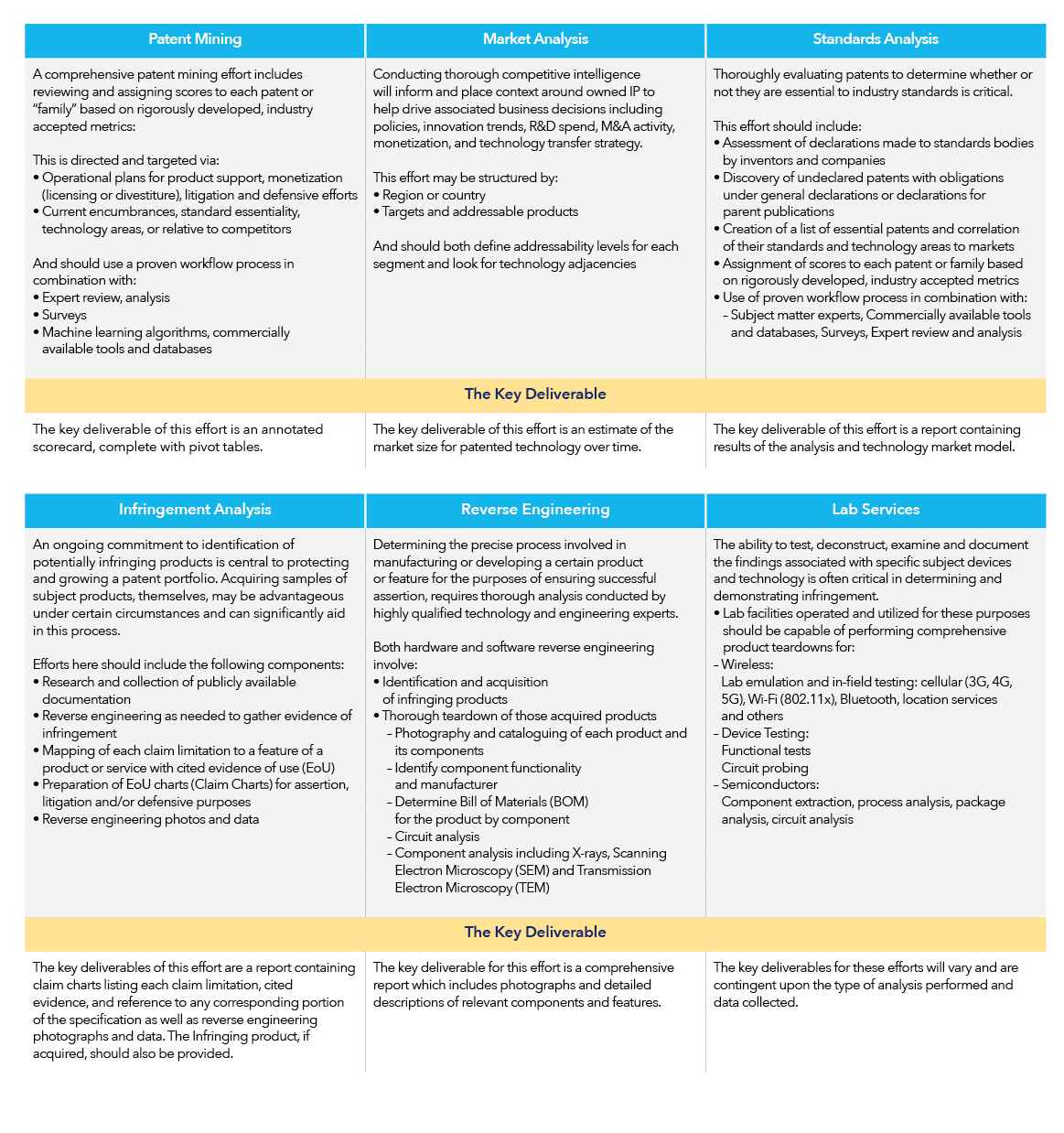Best Practices for Valuation, Assertion and Monetization of Technology Patent Assets

There was a time, not so long ago, when tangible assets comprised the vast majority of a company’s total value. A business’ equipment, real estate and other holdings were indeed its strongest suits in securing access to working capital and ensuring liquidity. While this remains the case today for most small- and medium-sized companies, we find that among large corporations, intangible assets including intellectual property (IP) now hold the lion’s share of value.
While this evolution has clearly occurred on a global basis, a look at data presented in the 2019 Intangible Assets Financial Statement Impact Comparison Report, published by Aon and Ponemon Institute and the associated charts below provide further insight into the extent of this shift in the balance of value. According to the report, 84% of the total value of S&P 500 companies in 2018 was attributable to intangible assets. Tangible assets comprised the remaining 16%.
One case in the last decade illustrates, perhaps better than any other since that time, the significance of this transition of value from tangible to intangible assets. Nortel, an early tech innovator which at its peak had a market cap of close to $300 billion, filed for bankruptcy protection in early 2009. As part of that bankruptcy proceeding, the Nortel patent portfolio was auctioned off and ultimately purchased by a consortium of six technology companies in 2011. This illustrious group included Apple, RIM, Microsoft, Sony, EMC and Ericsson. The price paid for the portfolio, which contained 6,000 patents and patent applications covering wireless, wireless 4G, data networking, optical, voice, internet, service provider, semiconductors and other patents, was astonishing to market onlookers at the time. At $4.5 billion, the final cash price was more than three times the amount of industry experts’ pre-auction estimates and far outweighed the $3.34 billion paid for all of the company’s other assets and business lines combined.


Our core team at Hilco IP Merchant Banking (HIPMB) is the very same team that was brought in by Nortel prior to its bankruptcy filing to evaluate and properly value its various patents. During that exhaustive process, we determined that although the company itself was in distress at the time, its patent portfolio most certainly was not. The resulting valuation that we were able to place on that portfolio, and the supporting technical, legal and market justification for that determination, directly impacted the record sale price received at auction.
In any discussion pertaining to patents, it is essential to first understand that they are a “negative right,” meaning that as a patent owner, you have the right to exclude others from using your/your company’s proprietary innovations. Patents protect inventions and patented inventions must be unique, useful and contain full instructions on their creation. Inventors must file an application to a national Patent Office where it’s validity will be assessed by technical experts, with each nation having its own specific set of eligibility criteria. Successful applications result in a granted patent with a protective term of 20 years. A patent owner must be able to clearly demonstrate from an objective, technical engineering perspective, that another party is using its innovation and is therefore required to pay a royalty for such use. HIPMB specializes in assessing the value of patent holdings. We hold the firm opinion that these valuations, themselves, must be accompanied by a level of comprehensive technical diligence comparable in scope to that which would be applied in reverse engineering of a potential infringer’s products to validate that their implementations do, in fact, violate the subject patents.
While obtaining patents that legally establish ownership of technology is a critical first step, this is only the beginning of a company’s patent journey. All too often, businesses that aggressively seek and obtain patents, for example, are far less focused or disciplined in establishing a formal plan and executing on that plan to both maintain control of, and leverage the true potential of those assets.
It has never been more essential than it is today for technology companies to commit to proactively protecting and growing their businesses by engaging in the steps that enable them to understand the full content and potential of their patent portfolios and make informed product, technology and investment decisions. Doing so can unlock the true value of these assets, revealing untapped collateral that can be used for investment in, or acquisition of, cutting edge technologies. This previously hidden value can also be put to work to generate new revenue streams via patent monetization and/or divestiture efforts. Lastly, leveraging these assets can strategically strengthen a business and expand opportunities through endeavors such as mergers, joint ventures and subsidiary creation. In our many years providing patent advisory and related services across the technology landscape, we have seen that businesses that embrace this philosophy and undertake such efforts are far better prepared to create strategies that enable them to both combat competitive threats against their patents and drive significant revenue from those assets in the future.
Consider the current COVID-19 crisis in which social distancing and lockdown requirements have impeded the profitability and growth of so many otherwise successful businesses worldwide. While companies across virtually every sector and industry continue to struggle, those with intangible IP assets such as patents and thorough portfolio monetization strategies are able to leverage those assets during this period to offset revenue loss via proactive licensing, sale, strategic alliance, as well as through infringement assertion efforts.
Companies would be well advised to seek proven expertise in developing a comprehensive and tailored patent protection and management strategy.
Such an effort should include detailed plans for 1) managing the costs of patent development and maintenance; 2) leveraging the patent portfolio to support regional and global business strategies; 3) benchmarking the portfolio and patenting strategy relative to the market and competitors and; 4) determining the most effective patent monetization strategy.
To be considered for engagement, firms should have proven technical analysis capabilities in areas including engineering, finance, and portfolio management. Firms should also follow recognized best practices in the areas of patent mining, market analysis, standards and infringement analysis, reverse engineering and lab services. We address each of these in detail below.

As specialists in all aspects of semiconductor and communications engineering, Hilco IP Merchant Banking (HIPMB) is a leader in patent-related due diligence including engineering, finance, and portfolio management. With more than 30 years of experience in telecommunications and wireless technologies, our highly experienced team of engineers and technologists has designed networks. We cut our teeth on 1, 2, 3 and 4G and understand at a deep, technical level where 5G is now headed and how it operates. When we perform diligence on patents for valuation purposes or undertake reverse engineering efforts for assertion, in many cases we actually know the individuals and teams who created the hardware and software that we are tearing down. Few in the industry can say the same.
Our semiconductor team built its experience at Broadcom, Agere, LSI, Lucent and AT&T Bell Labs. Our telecommunications team, as referenced earlier, built its experience at Nortel. We bring all of this knowledge and insight to bear in the work we do on behalf of our clients. In fact, over the course of just the past three years, HIPMB engineers have reverse engineered approximately 250 distinct smartphones, 75 consumer devices and 850 semiconductor chips. We have prepared technical materials for use in patent validity proceedings in the US, UK, Germany and China, have acted as expert witnesses in numerous patent infringement litigation cases, and have provided litigation support to numerous clients. Our work has included the review of patents for standards submissions and delivery of essentiality declarations to multiple standards bodies. Additionally, we have conducted investment diligence on several major patent portfolios that have come to market. Beyond this, our commitment and success is further validated by our own principal investing activities and our work on behalf of leading private equity investors, hedge funds, IP litigation funding firms, investment banks, restructuring and law firms.
Developing a sustainable and monetizable portfolio of high-value patent assets requires data-driven insights on portfolio health, market dynamics and fiscal impact. Whether your business is at the beginning of its patent journey or is well down the road with a sizable portfolio in hand, we can provide guidance and extensive expertise. From technical diligence exercises to large scale due diligence valuations and law firm/litigation assistance in both assertion and defense cases, we continue to be actively engaged by numerous businesses and firms throughout the pandemic period. We also remain in close touch with our many contacts, past clients and partners across Asia, Europe and the Americas. Please reach out to us today if we can be of assistance. We are here to help and welcome the opportunity to leverage our experience and relationships on behalf of your company or organization.
Hilco IP Merchant Banking (HIPMB)
HIPMB is a leading provider of Intellectual Property advisory services, integrating IP expertise and technical experience, with established business and market acumen. Our goal is to empower you to protect and grow your business by helping you understand the content and potential of your patent portfolio to make informed IP and technology investment decisions. We accomplish this by working closely with you to mine your portfolio, identify your best patent assets, improve your portfolio through continuation practice and identify products infringing your patents. We can further assist you in leveraging your assets through the reverse engineering of infringing products, demonstration of infringement with solid evidence of use by mapping out the specific details of infringement, as well as by supporting your licensing and litigation efforts. This not only provides a return on your IP investment by generating additional revenue, but strengthens your portfolio through industry recognition of its value.



